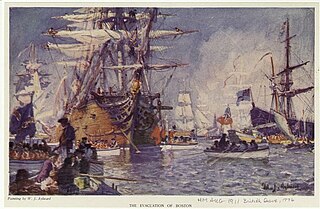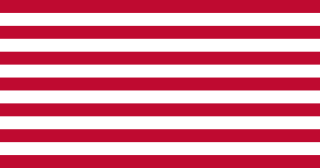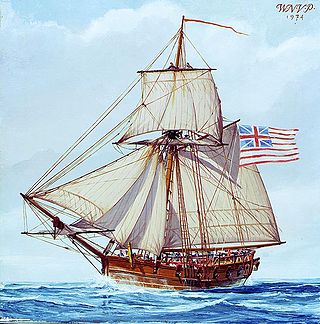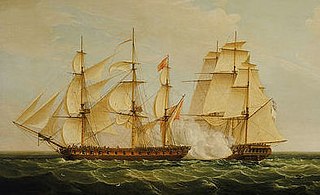
Lake Champlain is a natural freshwater lake in North America. It mostly lies between the US states of New York and Vermont, but also extends north into the Canadian province of Quebec.

The Battle of Valcour Island, also known as the Battle of Valcour Bay, was a naval engagement that took place on October 11, 1776, on Lake Champlain. The main action took place in Valcour Bay, a narrow strait between the New York mainland and Valcour Island. The battle is generally regarded as one of the first naval battles of the American Revolutionary War, and one of the first fought by the United States Navy. Most of the ships in the American fleet under the command of Benedict Arnold were captured or destroyed by a British force under the overall direction of General Guy Carleton. However, the American defense of Lake Champlain stalled British plans to reach the upper Hudson River valley.
USS Enterprise was a Continental Army sloop-of-war that served in Lake Champlain during the American Revolutionary War. She was the first of a long and prestigious line of ships of the United States or by the combatant forces of the U.S. Revolutionary War to bear the name Enterprise.

The siege of Boston was the opening phase of the American Revolutionary War. In the siege, American patriot militia led by newly-installed Continental Army commander George Washington prevented the British Army, which was garrisoned in Boston, from moving by land. Both sides faced resource, supply, and personnel challenges during the siege. British resupply and reinforcement was limited to sea access, which was impeded by American vessels. The British ultimately abandoned Boston after eleven months, moving their troops and equipment north, to Nova Scotia.

The Continental Navy was the navy of the Thirteen Colonies during the American Revolutionary War. Founded on October 13, 1775, the fleet developed into a relatively substantial force throughout the Revolutionary War, owing partially to the substantial efforts of the Continental Navy's patrons within the Continental Congress. These Congressional Patrons included the likes of John Adams, who served as the Chairman of the Naval Committee until 1776, when Commodore Esek Hopkins received instruction from the Continental Congress to assume command of the force.

USS Providence was a sloop-of-war in the Continental Navy, originally chartered by the Rhode Island General Assembly as Katy. The ship took part in a number of campaigns during the first half of the American Revolutionary War before being destroyed by her own crew in 1779 to prevent her falling into the hands of the British after the failed Penobscot Expedition.

The first USS Revenge was a Schooner in the Continental Navy. Revenge was built in the summer of 1776 by Colonel Jeduthan Baldwin at Fort Ticonderoga, New York.
The first USS New Haven was a gundalow built in 1776 on Lake Champlain, Capt. Mansfield in command, under General Benedict Arnold, who was a native of the ship's namesake city. New Haven took part in the engagement with the British Squadron at the Battle of Valcour Island on 11 and 12 October 1776. The New Haven was among those vessels deliberately grounded and burned preceding the American retreat overland to Crown Point and Fort Ticonderoga.

USS Philadelphia is a gunboat of the Continental Navy. She was constructed from July–August 1776 for service during the American Revolutionary War. Manned by Continental Army soldiers, she was part of a fleet under the command of General Benedict Arnold that fought against the British Royal Navy in the Battle of Valcour Island on Lake Champlain. Philadelphia was sunk during the battle on 11 October 1776.
The second Providence, a 28-gun frigate, built by Silvester Bowes at Providence, Rhode Island, by order of the Continental Congress, was launched in May 1776.

HMS Alceste was built at Rochefort in 1804 for the French Navy as Minerve, an Armide-class frigate. In the spring of 1806, prior to her capture, she engaged HMS Pallas, then under Lord Cochrane. During the duel she ran aground but Cochrane had to abort his attack when French reinforcements appeared.
USS Providence, a gundalow, was built at Skenesboro, New York, on Lake Champlain by the Continental Army for Brigadier-General Benedict Arnold's fleet on Lake Champlain in 1776, during the American Revolutionary War.
USS Lee was a galley built for the Continental Navy during the American Revolution. She participated in the Battle of Valcour Island during which she was grounded and lost. However, her participation in the battle helped delay the British advance on New York City by a year.
USS Spitfire was an American gundalow that operated as a gunboat in 1776 on Lake Champlain. She was part of Benedict Arnold's small, hastily built fleet of ships whose purpose was to counter any British invasion forces passing through the lake from Canada. Her service life was brief; after only a few months patrolling the lake she was lost in the aftermath of the Battle of Valcour Island. The gunboat's wreck was located and documented in the 1990s by the Lake Champlain Maritime Museum.

USS Valcour (AVP-55), later AGF-1, was a Barnegat-class seaplane tender of the United States Navy, in commission as a seaplane tender from 1946 to 1965 and as a flagship from 1965 to 1973.

American colonial marines were various naval infantry units which served during the Revolutionary War on the Patriot side. After the conflict broke out in 1775, nine of the rebelling Thirteen Colonies established state navies to carry out naval operations. Accordingly, several marine units were raised to serve as an infantry component aboard the ships of these navies. The marines, along with the navies they served in, were intended initially as a stopgap measure to provide the Patriots with naval capabilities before the Continental Navy reached a significant level of strength. After its establishment, state navies, and the marines serving in them, participated in several operations alongside the Continental Navy and its marines.
New York (1776) was a gunboat built in 1776 at Skenesboro, New York. It was originally called Success prior to launch for service in General Benedict Arnold's fleet on Lake Champlain. New York may be named after the City of New York, because other ships in the fleet were named after cities, however, it could be named after the State of New York, because at least one or two other ships, Connecticut and Jersey, sometimes referred to as New Jersey, were named after states.

HMS Pearl was a fifth-rate, 32-gun British Royal Navy frigate of the Niger-class. Launched at Chatham Dockyard in 1762, she served in British North America until January 1773, when she sailed to England for repairs. Returning to North America in March 1776, to fight in the American Revolutionary War, Pearl escorted the transports which landed troops in Kip's Bay that September. Much of the following year was spent on the Delaware River where she took part in the Battle of Red Bank in October. Towards the end of 1777, Pearl joined Vice-Admiral Richard Howe's fleet in Narragansett Bay and was still there when the French fleet arrived and began an attack on British positions. Both fleets were forced to retire due to bad weather and the action was inconclusive. Pearl was then despatched to keep an eye on the French fleet, which had been driven into Boston.

Royal Savage was a two-masted schooner built by the British in the summer of 1775. She was damaged and sunk by soldiers of the United Colonies during the Siege of Fort St. Jean and later raised and repaired after the fort was captured. She then participated in General Benedict Arnold's campaign on Lake Champlain. The British captured and burnt her in October 1776 at Valcour Island.
The first USS Trumbull was a row galley built in 1776 at Skenesboro, New York, for service in General Benedict Arnold's fleet on Lake Champlain. She was launched on 10 September 1776 and began active service soon thereafter, Capt. Seth Warner in command.












